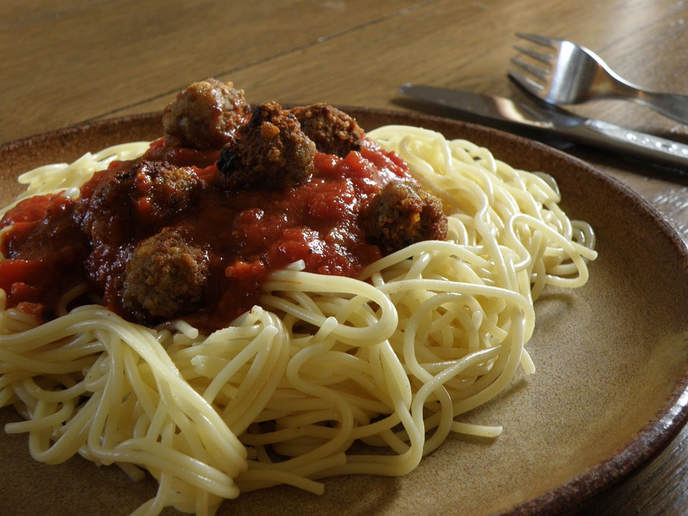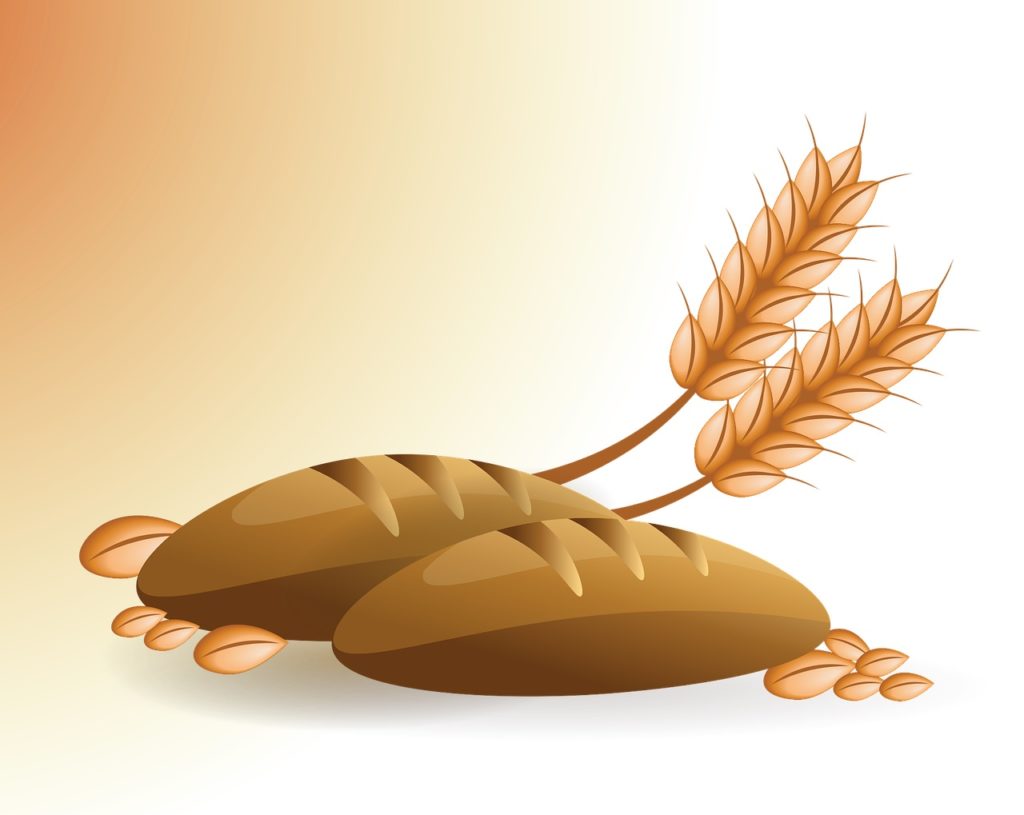Modern Grains & Inflammation Go Together Like Spaghetti and Meatballs

“Although the cause of increased prevalence of wheat sensitivity over the last several decades remains unknown, modern wheat processing techniques may have increased consumer exposure to immunoreactive compounds.” From the February 1015 issue of Comprehensive Reviews in Food Science and Food Safety (A Grounded Guide to Gluten: How Modern Genotypes and Processing Impact Wheat Sensitivity)
“One of the issues of whole wheat flour production is the lack of well-established milling procedures. Whole grain flours are produced by a variety of techniques and result in flours with widely different particle sizes and functionalities. Another issue with whole wheat flour utilization is shelf-life. Whole wheat flour is highly susceptible to rancidity due to the presence of lipolytic enzymes.” Andres F Doblado-Maldonado from his 2012 Masters Thesis at the University of Nebraska, New Technologies for Whole Wheat Processing Addressing Milling and Storage Issues
I already know that this post is going to create a firestorm of controversy. That’s OK. Understand that it’s not geared towards everyone — only those who are chronically ill (HERE), chronically overweight (about 80% of the US population when you factor in the 8-10% who are “SKINNY FAT“), or dealing with CHRONIC PAIN — according to estimates, as many as 100 million Americans. The fact that people question that grains could be part of their health problem(s) is legitimate — I’ve asked some of the same questions myself.
For instance, how can common grains from the Bible (wheat, corn, barley, rye, oats, millet, emmer, etc) somehow be bad? I will get to that, but for the time being, realize that the grains we are consuming today are radically different from the grains your grandparents were consuming — let alone Moses or Jesus.
The first thing I want everyone to realize is that not everyone is sensitive to GLUTEN or other grains, which, by the way, are virtually all GLUTEN CROSS-REACTORS. Some of you can handle these with no apparent problems. But also understand that just because a problem is not “apparent” does not necessarily mean it doesn’t exist.
This is especially important once you realize that when it comes to NON-CELIAC GLUTEN SENSITIVITY (NCGS), the majority of the symptoms don’t manifest like we’ve always been taught they do — bloating, gas, CONSTIPATION, DIARRHEA, IBS, etc, etc). They manifest “extra-intestinally” or outside of the Gut.
For example, numerous studies show that over half of all NCGS manifests neurologically (HERE and HERE). But Gluten is only part of what makes grain a potential Burmese Tiger Pit waiting to destroy unwary (or uneducated) victims.
Grains can be divided into two large categories; these are legumes, which include all types of BEANS (UNFORTUNATELY, SOY) and the cereal grains (wheat, rye, barely, corn, etc, etc, etc). All have three main parts; the bran, the germ, and the endosperm. The bran, or “husk” of each kernel, is where MOST OF THE FIBER is found. It’s also where part of the B-VITAMINS and most of the minerals are found, as well as the majority of the oils (it’s the oils that tend to go rancid fairly quickly once the grain is milled).
The bran also happens to be where the phytates, one of the “ANTI-NUTRIENTS” found in many grains, are found (other anti-nutrients that may or may not stimulate health problems such as LEAKY GUT include Lectins, Saponins, Oxolates, Lippopolysacharides, and potentially several others).
The germ is the part of the grain that actually sprouts and becomes a new plant. The rest of the B-Vitamins are found here, as well as ANTIOXIDANTS and the rest of the oils. It contains several vitamins and minerals, as well as being made up of about one third protein. The endosperm is not only the by far the biggest part of the grain, it’s where the majority of the starchy carbohydrate meant to feed the “germinated” seed is found.
When compared to the rest of the grain, the endosperm has little nutritional value other than providing a source of simple carbohydrate. The USDA, which as I have told you previously, is an organization whose chief concerns have little to do with health, but rather the promotion of US agriculture both domestically and around the world, says on their website (Choose My Plate) that, “Most Americans consume enough grains, but few are whole grains.”
What’s the difference?
“Whole grains contain the entire grain kernel ― the bran, germ, and endosperm. Refined grains have been milled via a special process that removes the bran and germ. This is done to give grains a finer texture and improve their shelf life, but it also removes dietary fiber, iron, and many B vitamins. Most refined grains are enriched.”
Once the grain has been refined, chemicals, including bleach, are used, not to whiten the flour or to kill bugs as most people believe, but to destroy any living part of the grain remaining from the milling process. This is because in virtually all cases, manufactures need dead flour made from dead starch. You’ll see why this is so important in a moment.
First and foremost, the quote above shows that most Americans are not eating whole grains (and when they do, they are largely being duped as you’ll also see shortly). Secondly, the grain-based products they are eating are usually highly refined (the bran and germ are removed). Why? Because flour that is not heavily refined not only spoils and goes rancid quickly, it tends to attract weevils and other critters (those of you who are old enough know what I am talking about).
By removing or killing the vital, living, and nutrient-rich part of the grain, food manufacturers can provide retailers and consumers flours and products that in many cases have an almost unlimited shelf-life. For instance, breakfast cereal might get a bit stale once the bag has been opened, but left in your pantry for a decade, it will not spoil or rot. And what about the whole “enrichment” thing I mentioned earlier?
Enrichment is what politicians do at the expense of the citizens they are supposed to represent. It’s also one of the many ways food manufactures dupe people who don’t know better. I have a friend who is in the pet food manufacturing industry. He tells me that synthetic vitamins & minerals are not only widely available, but dirt cheap.
This is why manufacturers can advertise that radically unhealthy breakfast cereals such as Count Chocula, Coco Puffs, Donutz, Captain Crunch, Golden Grahams, Froot Loops, Trix, Super Sugar Crisp, Apple Jacks, Honey Smacks, METH & CRACK, and a myriad of others, are “fortified” with the whole day’s supply of a dozen or so essential vitamins and minerals.
If you aren’t familiar with the difference between nutrition that comes from food and the synthetic garbage added to these products so industry can make absurd claims about nutrition (for instance, Total Cereal claims to supply, “100% of the Daily Value of 11 vitamins and minerals“), then you need to read THIS.
MODERN GRAINS ARE NOT AS HEALTHY AS WE’VE BEEN LED TO BELIEVE
THE FIRST SMOKING GUN

“So what’s changed? In fact, almost everything. The way we grow it, the way we process it and the way we eat. The very wheat itself. Since industrialization, everything has changed, and it has happened in two distinct ‘technology revolutions’. The first was in milling, the second in cultivation and farming. Both have had a profound effect, yet most people have no idea.” Cherry-picked from David Zivot’s GrainStorm site (What’s Wrong With Modern Wheat?)
I think that our “smoking guns” can be boiled down to three main categories, hybridization / GMO, modern milling methods, and chemical saturation. How big a deal has hybridization and GMO been as far as health problems are concerned? Despite what we keep hearing from our government; huge for susceptible individuals.
This is mostly due to the fact that modern hybrids and GMO’s (or funky combinations of the two) can not only contain larger amounts of certain proteins than older (ancient) varieties of grain did, but in some cases, have been shown to contain proteins that did not used to exist at all.
Either way you slice it, people’s bodies are reacting to these as foreign and then mounting immune system attacks against them, which as strange as it may seem, is a known trigger for the body mounting immune system attacks against itself in the form of autoimmunity. This is not a new or novel concept, having been known since the 1930’s — HERE & HERE. What are some of America’s leading authorities saying on the subject?
Renowned Naples neurologist, DR. DAVID PERLMUTTER of NYT bestseller Grain Brain fame, stated that, “The problem with gluten is far more serious than anyone ever imagined. Modern…structurally modified, hybridized grains contain gluten that’s less tolerable than the gluten that was found in grains cultivated just a few decades ago.“
FUNCTIONAL MEDICINE expert, Dr. Mark Hyman (MD) says of these modern grains, “This new modern wheat may look like wheat, but it is different in three important ways that all drive obesity, diabetes, heart disease, cancer, dementia and more. It contains a super starch, amylopectin A, that is super fattening, a form of super gluten that is super inflammatory, and acts like a super drug that is super addictive and makes you crave and eat more.” Can anyone say GLUTOMORPHIN?
Dr William Davis (MD) who wrote the legendary book Wheat Belly stated that, “This stocky little high-yield plant, a distant relative of the wheat our mothers used to bake muffins, biochemically light-years removed from the wheat of just 40 years ago.“
And to top it all off, my mom’s first cousin, DR. JAMES BRALY, a nationally respected expert on the immune system and natural allergy relief (not to mention, long-time physician to the rich and famous) was lecturing and writing about the health problems associated with grains clear back in 2002. In his hit book, Dangerous Grains, he lists on the back jacket some of the health problems connected with the consumption of modern grains via peer-review….
- CANCER
- AUTOIMMUNE DISEASES (A list of the more common ones can be found HERE.)
- BRAIN DISORDERS
- OSTEOPOROSIS
- INTESTINAL DISEASE (This covers a lot of ground, including not only pathological issues such as IBS and IBD, but “FUNCTIONAL ISSUES” such as LEAKY GUT and the screwed up MICROBIOMES we collectively refer to as “DYSBIOSIS“. For those of you with IBS, it is critical you understand FODMAPS.)
- DIGESTIVE DISORDERS (One that’s been related to grain that plagues a huge segment of our population is something called HYPOCHLORHYDRIA. If you are on ACID BLOCKING DRUGS you really need to understand this bullet.)
- CHRONIC PAIN
- INFERTILITY & PROBLEM PREGNANCIES
THE SECOND SMOKING GUN
Modern Milling Methods

“Even orthodox nutritionists now recognize that white flour is an empty food, supplying calories for energy but none of the bodybuilding materials that abound in the germ and the bran of whole grains. Problems occur when we are cruel to our grains—when we fractionate them into bran, germ and naked starch; when we mill them at high temperatures; when we extrude them to make crunchy breakfast cereals; and when we consume them without careful preparation. Grains require careful preparation because they contain a number of antinutrients that can cause serious health problems.
Phytic acid, for example, is an organic acid in which phosphorus is bound. It is mostly found in the bran or outer hull of seeds. Untreated phytic acid can combine with calcium, magnesium, copper, iron and especially zinc in the intestinal tract and block their absorption. This is why a diet high in improperly prepared whole grains may lead to serious mineral deficiencies and bone loss.
The modern misguided practice of consuming large amounts of unprocessed bran often improves colon transit time at first but may lead to irritable bowel syndrome and, in the long term, many other adverse effects.” Sally Fallon and Mary Enrig from the WESTON PRICE FOUNDATION (Be Kind to Your Grains And Your Grains Will Be Kind To You)
“Our rallying cry is ‘Bake Like it’s 1869’. That’s because, in the 1870’s, the invention of the modern steel roller mill revolutionized grain milling. Instead of just mashing it all together, one could separate the component parts… And, beyond being cheap and wildly popular, this new type of flour shipped and stored better, allowing for a long distribution chain. In fact, it kept almost indefinitely.
Pest problems were eliminated because pests didn’t want it. Of course, we now know that the reason it keeps so well is that it has been stripped of vital nutrients. The steel roller mill became so popular, so fast, that within 10 years nearly all stone mills in the western world had been replaced. And thus was born the first processed food and the beginning of our industrial food system: where vast quantities of shelf-stable ‘food’ are produced in large factories, many months and many miles from the point of consumption.” Fron Zivot’s GrainStorm site (the article mentioned earlier)
“Stone mills are the oldest attrition mills used for making whole grain flours, which simultaneously use compression, shear, and abrasion to grind wheat kernels between two stones and produce a theoretical extraction rate of 100%. Modern stone mills are metal plates with composition stones attached and generate considerable heat due to friction. This can result in considerable damage to starch, protein, and unsaturated fatty acids in comparison with other milling techniques.
Furthermore, in large, continuous milling operations, heat generated from stone milling can pose a fire risk. Interestingly, there appears to be a marketing advantage by using the term ‘stone ground’ with consumers.” From Andres F Doblado-Maldonado’s 2012 Masters Thesis, New Technologies for Whole Wheat Processing Addressing Milling and Storage Issues at the University of Nebraska
“A report written under the guidance of the American Association of Cereal Chemists International Whole Grain Working Group (WGWG) asserted existing data comparing the two principal means of manufacturing whole wheat flours and meals — single-stream milling and multiple-stream milling with recombination — do not show any strong advantage for either milling method with regard to maintaining the nutritional value of the whole grain. Whole grain meals and flours mostly were manufactured by mills using a multiple-stream with recombination process.
Some sources have voiced concerns that milling processes that separate and combine millstreams may capture fewer whole grain components and their nutrients, fiber and micro-constituents than milling processes that never separate millstreams. In multiple-stream milling with recombination, the grain is crushed, and different grain fractions are channeled into separate millstreams.
When crushed and separated products of milling, specifically the bran, germ, endosperm, and minor milling fractions (from the same grain), are reunited at the point of use by the food manufacturer, the process is called reconstitution. The contribution of single-stream milling to whole grain foods in Western diets is minimal…
Manufacturers reconstituting whole grain flour in the manufacture of their whole grain food products must exercise diligence to ensure that the proportions of the various components meet the standards set by the AACCI whole grain definition.” Cherry-picked from a 2015 paper by Josh Sosland on World-Grain (Comparing Whole Grain Milling Methods)
The second “smoking gun” has to do with the way that our modern grains are milled. For thousands of years grains were milled between pieces of wood, stones, or both. The nature of this flour was that it was coarse — often times very coarse.
It was also common to soak grains, sprout grains, and sour the dough; all processes that made digesting them easier. Today we take grains that have often times been stored in bins or grain elevators with an array of seriously toxic chemicals (next smoking gun), and then we mill it at extremely high speeds (I’ve seen some that claim tens of thousands of RPMs). Not only is this product not being mixed with beans, nuts, and other grains, it is frequently being ground to the consistency of talc.
Understand that none of this guarantees you are going to have health problems because of the grain, but numerous experts believe it dramatically increases your chances. This increased probability that grains are problematic is a combination of individual genetic makeup and the way they are affected by their environment.
Why do some people have such serious trouble digesting and assimilating grain while others remain — at least seemingly so — unfazed? Much of it has to do with something called epigenetics. Interestingly enough, I showed you this back when I showed you how Gluten Sensitivities (CELIAC DISEASE Included) start (HERE). It seems that Sayer Ji, author of The Dark Side of Wheat would agree.
Pay attention to the fact that EPIGENETIC FACTORS far outweigh the genetic factors when it comes to developing grain sensitivities (as I’ve told you over and over again on this site, you can no longer blame mom or dad for your health problems, even though Big Pharma wants you to believe otherwise (HERE)).
“It Is Not In the Genes, But What We Expose Them To. Despite common misconceptions, monogenic diseases, or diseases that result from errors in the nucleotide sequence of a single gene are exceedingly rare. Perhaps only 1% of all diseases fall within this category, and Celiac disease is not one of them. The “blueprint” model of genetics: one gene → one protein → one cellular behavior, which was once the holy grail of biology, has now been supplanted by a model of the cell where epigenetic factors (literally: “beyond the control of the gene”) are primary in determining how DNA will be interpreted, translated and expressed.
It is the epigenetic factors, e.g. regulatory proteins and post-translational modifications, that make the determination as to which genes to turn on and which to silence, resulting in each cell’s unique phenotype. Moreover, epigenetic factors are directly and indirectly influenced by the presence or absence of key nutrients in the diet, as well as exposures to chemicals, pathogens and other environmental influences. In a nutshell, what we eat and what we are exposed to in our environment directly affects our DNA and its expression.
The implications of these findings are rather extraordinary: epigenetic and not genetic factors are primary in determining disease outcome. Even if we exclude the possibility of reversing certain monogenic diseases, the basic lesson from the post-Genomic era is that we can’t blame our DNA for causing disease. Rather, it may have more to do with what we choose to expose our DNA to.”
Industry will, for the most part, tell you that none of this really matters, trying to convince you that the power is all in the gene; all the while pumping out studies showing their products in a favorable light. In lots of ways it’s almost identical to the phenomenon of “HOMEGROWN RESEARCH” coming out of the sugar industry; or the tainted studies being pumped out by the PHARMACEUTICAL INDUSTRY. As I’ve shown you time and time again (HERE), trust peer-review at your own peril. Which brings us to that final smoking gun.
The Third Smoking Gun of Gluten Intolerance
Chemicals, Pesticides & Herbicides

Although a case could be made for several more, my third and final smoking gun has to do with the CHEMICALS, HERBICIDES, AND PESTICIDES that all modern grain production requires (can anyone say GLYPHOSATE?). Modern grains are hit with NASTY CHEMICALS a minimum of twice; once in the field and again during storage. I’ll not spend time on this as most of you are aware that exposure to synthetic chemicals is bad for you — it’s one of those rare things in healthcare that we can all agree on (not sure why that doesn’t seem to translate over to DRUGS and VACCINES?).
And not only are these chemicals carcinogenic, most have the ability to act as XENO-HORMONES, feminizing the males of every species (HERE), while causing something called ESTROGEN DOMINANCE not only in women, but in men as well.
What should you do? Like I said, grains are not a significant health issue for some people. However, if you are one of the people I mentioned at the beginning of today’s post (or have a strong family history of certain chronic diseases), I would strongly suggest you do an ELIMINATION DIET, which will entail cutting grains out of your diet for at least a month. An Elimination Diet is the most accurate way to determine what foods you might have problems with, including grains.
Let me leave you something to think about while contemplating today’s post. When I was growing up in the FLINT HILLS of extremely rural Kansas, ranchers whose beef grazed the prairie would take their livestock to the feedlots in the western part of the state to be “finished”. This is where the beef is given copious amounts of grain the last couple months of their lives. Why?
Sure, everyone raves about the taste of grain-fed beef —- after all, it’s the fat that largely gives meat it’s flavor. But where’s all that fat come from? Largely from the grain — I’ll not even go into the whole LOW-DOSE-ANTIBIOTICS-FOR-FATTENING-YOUR-LIVESTOCK thing here). It’s important for you to be aware that commercially-raised, grain-fed beef is often referred to in peer-review as “obese”.
Although there are literally dozens of reasons that a grain-based diet might not be in your best interest if you have chronic health issues OR A FAMILY HISTORY OF SUCH (HERE, HERE, HERE, HERE, HERE, HERE, and HERE are some reasons, as well as hundreds you can look up yourself on the sites of ROBB WOLF, MARKS SISSON, ART AYERS, or any number of others), the biggest has to be that modern grains are inflammatory as opposed to anti-inflammatory (HERE). Why is this a big deal?
OBESITY is one of the numerous health problems caused by inflammation (HERE), which in turn causes inflammation. And the doubly crazy thing is that excessive adipose tissue (PARTICULARLY IN THE FORM OF BELLY FAT) is not only itself inflammatory, it actually creates estrogen (HERE), which is the hormone commercial livestock producers give animals to make them fatter (click the link found in the paragraph underneath the pic above).
It’s a big round-robin of inflammation, obesity, and increasing ENDOCRINE FUBAR (CARDIOMETABOLIC SYNDROME, ADRENAL FATIGUE / FIBROMYALGIA, LOW T — or for you women, HIGH T — THYROID ISSUES, all sorts of “LEAKIES“, etc, etc, etc, etc) that may or may not be a culprit in your chronic health conditions.
“Renowned gluten intolerance researcher, Dr. Kenneth Fine, believes 1 in 3 Americans are gluten intolerant and 8 in 10 has the genetic wiring to develop it.” Mike Sheridan’s article (Grains – What’s the Upside?) From Robb Wolf’s website. BTW, Dr. Fine is an MD who founded Enterolab. For the record, I think Cyrex is significantly better than Enterolab.
What Kind of Meat Should You Be Eating if You Eat Meat?
Could Eating Grain-Fed Meat Affect Your Health?

“Cows naturally do not have so much fat, but in the USA most are fattened before slaughter. They are placed in feed lots their last 4 to 6 months of life and fed 20 to 25 pounds of various grains and soybeans every day, and the result is a huge increase in body fat. Cows slaughtered directly from pasture have far less fat between their muscle fibers and that overlying them.” From Baylor University Medical School Proceedings (Twenty Questions on Atherosclerosis)
Not only does the OZARKS have an overabundance of DEER (these are acorn-fed as we do not have grain in these parts), fortunately there are ANY NUMBER OF RANCHERS in this neck of the woods getting with the program by raising beef (or chicken) that is healthy and delicious in every sense of the word. In our neighborhood, make sure to talk to FRESCOLN RANCH or CLUCK RANCH about their beef (the Clucks have sheep and goats as well).
Speaking of farm animals, let’s talk for a moment about the effects that grains have on them. It’s really quite simple, feed a ruminant copious amounts of grain, and they gain copious amounts of weight. While the same thing is true of people, what I want to discuss today is what it does to Gut Health. Because your health starts in your Gut, anything that fouls Gut Health is going to foul your overall health (HERE).
According to the Alabama Cooperative Extension System (Digestive System of Goats), “Mature goats are herbivorous ruminant animals. Their digestive tracts, which are similar to those of cattle, sheep, deer, elk, bison, and giraffes, consist of the mouth, esophagus, four stomach compartments, small intestine, cecum, and large intestine.” What I want to discuss is what happens when herbivores (animals designed to eat foliage, vegetation, plants, etc; not grains) are instead fed large amounts of grains (60-65% grains).
The April 2013 issue of Anerobe (Grain-Rich Diets Differently Alter Ruminal and Colonic Abundance of Microbial Populations and Lipopolysaccharide in Goats) said that, “High grain feeding has been associated with ruminal pH depression and microbial dysbiosis in cattle.”
This dysbiosis is likely due to increased lipopolysaccharide concentrations in the Gut. What are lipopolysaccharides (LPS) and why does it matter? LPS are found on the membrane of gram negative bacteria and frequently lead to serious immune system reactivity. They act as endotoxins, not only causing the release of pro-inflammatory cytokines, but inducing “superoxide / hyperoxide” production (high-powered, cancer-causing Free Radicals).
Furthermore, because parts of these LPS look similar enough to human cellular molecules, having large amounts of them running around your system tends to cause two distinct problems. They can hide and not be properly dealt with by your immune system. Or the immune system starts attacking them, and accidentally starts attacking self because of the similarities (autoimmunity).
A study published four months later in the August issue of the American Journal of Physiology: Regulatory, Integrative, and Comparative Physiology had a “massively” interesting title —- A High-Grain Diet Causes Massive Disruption of Ruminal Epithelial Tight Junctions in Goats. How massive is the Leaky Gut issue here? After seven weeks of feeding goats a high grain diet…
“Free LPS in the peripheral blood was detectable, while not detectable in the control, suggesting a leakage of LPS into the blood in the high grain group. Correspondingly, the high grain goats showed profound alterations in ruminal epithelial structure and tight junction proteins, depicted by marked epithelial cellular damage and intercellular junction erosion, down-regulation of tight junction proteins. These results demonstrated for the first time that the high grain diet caused disruption of ruminal epithelial tight junctions was associated with a local inflammatory response in the rumen epithelium.”
When tight cellular junctions become loose, the corresponding “leakiness” allows particles of God-knows-what to freely move from the Gut to the circulating blood where they become immuno-reactive. There were so many studies on this topic I could have written a book. Allow me to hit you with one more that was published in August of 2017.
The journal Applied Microbiology and Biotechnology (High-Grain Diets Altered Rumen Fermentation and Epithelial Bacterial Community and Resulted in Rumen Epithelial Injuries of Goats) looked as seven weeks of high grain diet and concluded that, “levels of volatile fatty acids and lipopolysaccharides were higher in the high grain group than those in the hay group.”
To see how severely this affected inflammatory response in an epigenetic manner, take a gander at this. Along with the dysbiosis, “the high grain group had a higher relative abundance of gene families related to energy metabolism [potential weight gain]; folding, sorting, and degradation; translation; metabolic diseases; and immune system [making them more prone to autoimmunity]. Furthermore, high grain feeding resulted in epithelial injury and upregulated the gene expressions of IL-1β and IL-6, and the upregulations were closely related to the rumen pH, LPS level, and rumen epithelial bacteria abundance.”
In other words, grain was the trigger for leaky epithelial barriers, which led to rampant inflammation.
The bottom line is that today’s grains are nothing like yesterday’s grains. And furthermore, consuming these grains has great potential (key word here is potential) to put you on what I call THE UNIVERSAL CYCLE OF SICKNESS, PAIN, AND DISEASE (click and scroll to circular diagram). If you are struggling with chronic pain or chronic conditions, an important part of your recovery will be getting off grains. Period.
